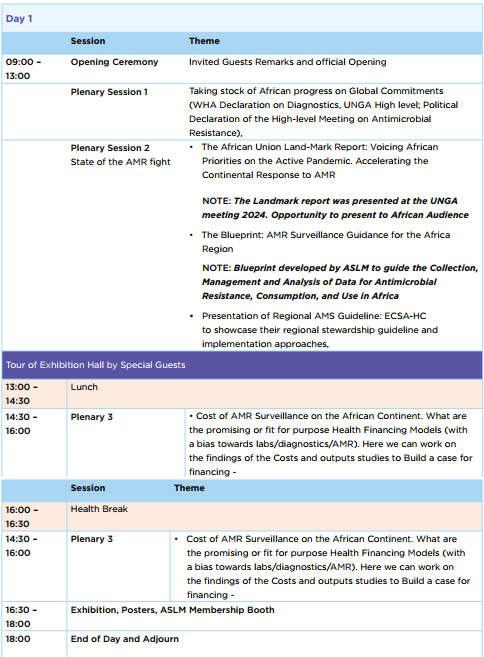Program & Agenda
► Day 1: Global Commitments and African Priorities
Opening Ceremony:
Formal inauguration featuring high-level African and international dignitaries reaffirming commitments to
the AMR agenda.
Plenary Session 1:
Overview of global frameworks — the WHA Declaration on Diagnostics, the UNGA Political Declaration on
AMR, and their implications for Africa.
Plenary Session 2:
African Union Landmark Report: Presentation and discussion of the African Union Landmark
Report on AMR, focusing on African priorities, challenges, and strategies to accelerate AMR
response.
- ASLM Portfolio Showcase: Detailed presentation of ASLM’s AMR initiatives including:
i. The External Quality Assessment (EQA) Business Plan ensuring laboratory testing quality and
reliability.
ii. The AMR Knowledge Hub, a collaborative platform for sharing data, best practices, and
innovations.
iii. The MAAP Store visualization tool for real-time AMR data analytics and surveillance.
iv. Workforce professional qualifications and fellowship programs strengthening laboratory
expertise continent-wide. - Presentation of the AMR Surveillance Blueprint: A step-by-step guidance document developed
by ASLM for standardized data collection, management, and analysis of AMR, antimicrobial
consumption, and use in Africa. - Presentation of Regional AMS Guideline: ECSA-HC to showcase their regional stewardship
guideline and implementation approaches,
Exhibition Hall Tour:
Special guests visit displays from diagnostic companies, research institutions, and implementing partners
demonstrating innovations and tools advancing AMR surveillance and diagnostics.
► Day 2: Financing Models and Sustainability
Plenary Session:
What is the economic cost of implementing and establishing AMR surveillance systems? What are
the cost drivers of AMR surveillance systems in Africa?
Strategy for leveraging this business case to secure funding and build partnerships.
Present promising financing models with a focus on laboratories and diagnostics, including case
studies of successful country-level implementation.
ASLM Business Case Presentation:
An evidence-based, compelling business case for AMR surveillance investment, aligned with the
Political Declaration’s target to mobilize US$100 million to catalyze funded AMR plans by 2030.
Invitation for Funding Pledges:
Funders, governments, and private sector actors invited to commit resources towards closing the AMR
financing gap.
Break-Away Sessions: :
Focused discussions to explore cross-cutting themes:
Break-Away 1: Industry Forum.
Break-Away 2: Workforce development and capacity building.
Break-Away 3: Diagnostic innovations and implementation challenges.
Break-Away 4: Health financing and resource mobilization strategies.
Exhibition Hall Tour:
Special guests visit displays from diagnostic companies, research institutions, and implementing partners
demonstrating innovations and tools advancing AMR surveillance and diagnostics.
► Day 3: Role of Civil Society in Diagnostics
Plenary Session:
Round table discussions with Civil Society on their role in Diagnostics with bias towards AMR
Break-Away Sessions:
Break-Away 4: Health financing and resource mobilization strategies.
Break-Away 1: Lab Leadership.
Break-Away 2: Workforce development and capacity building.
Break-Away 3: Diagnostic innovations and implementation challenges.
Expected Outcomes:
Enhanced stakeholder awareness and commitment to the AMR agenda, particularly related to
diagnostics and surveillance.
Accelerated access to innovative diagnostics by addressing barriers and leveraging opportunities
across the entire ecosystem – from R&D and manufacturing to availability, adoption, and long-term
sustainability
Greater alignment of continental AMR priorities with global mandates and African Union strategies.
Increased visibility and adoption of ASLM tools and resources for quality-assured diagnostics and
data-driven AMR surveillance.
Concrete financial commitments and partnership agreements supporting the sustainability of AMR
surveillance systems.
Actionable roadmaps and country-level strategies for scaling up diagnostic capacity, data
management, and workforce development.
Strengthened multi-sectoral collaboration involving governments, laboratories, industry partners,
funders, and civil society.
Target Audience:
African Union Commission and regional health entities (e.g., Africa CDC)
- Ministries of Health, Finance, and Planning from African countries
- Laboratory scientists, clinicians, and public health professionals
- International and African development partners, donor agencies, and private sector funders
- Academic and research institutions specializing in AMR and diagnostics
- Civil society and advocacy groups focused on health security and antimicrobial stewardship
Agenda
► DAY 1 Agenda

► DAY 2 Agenda

► DAY 3 Agenda


